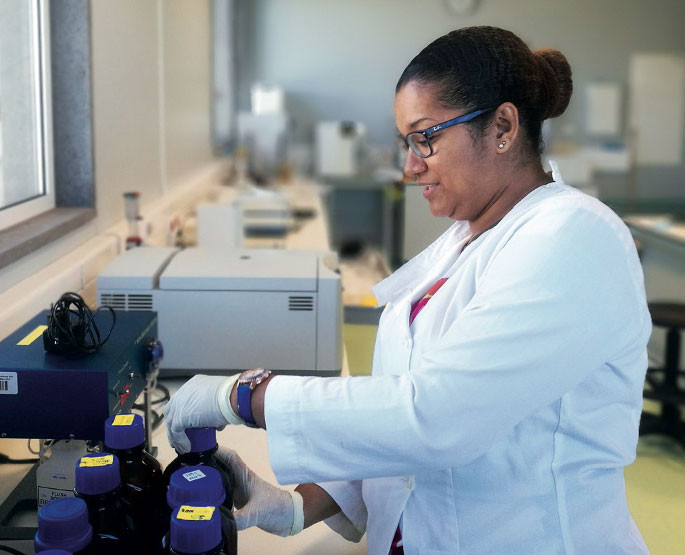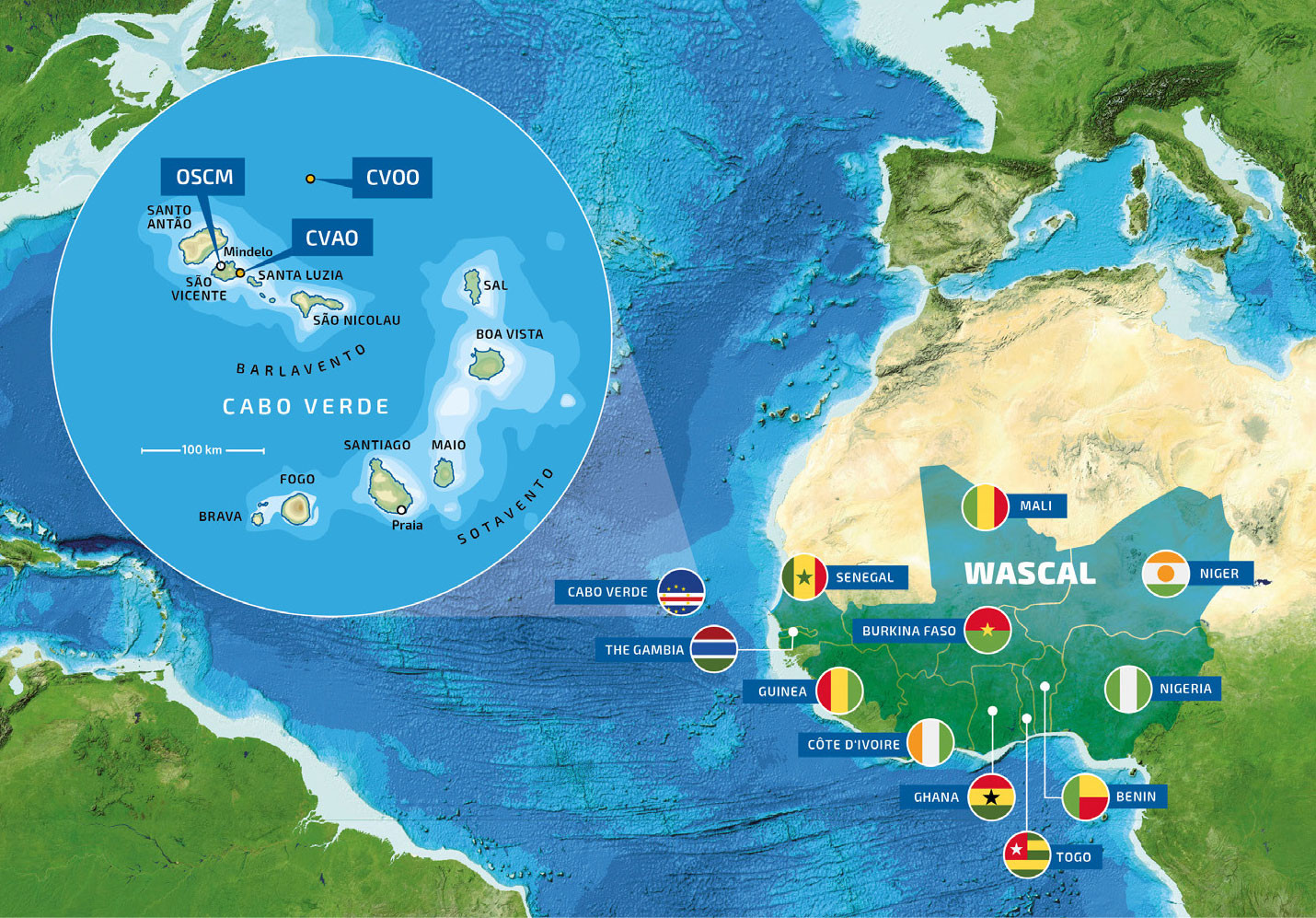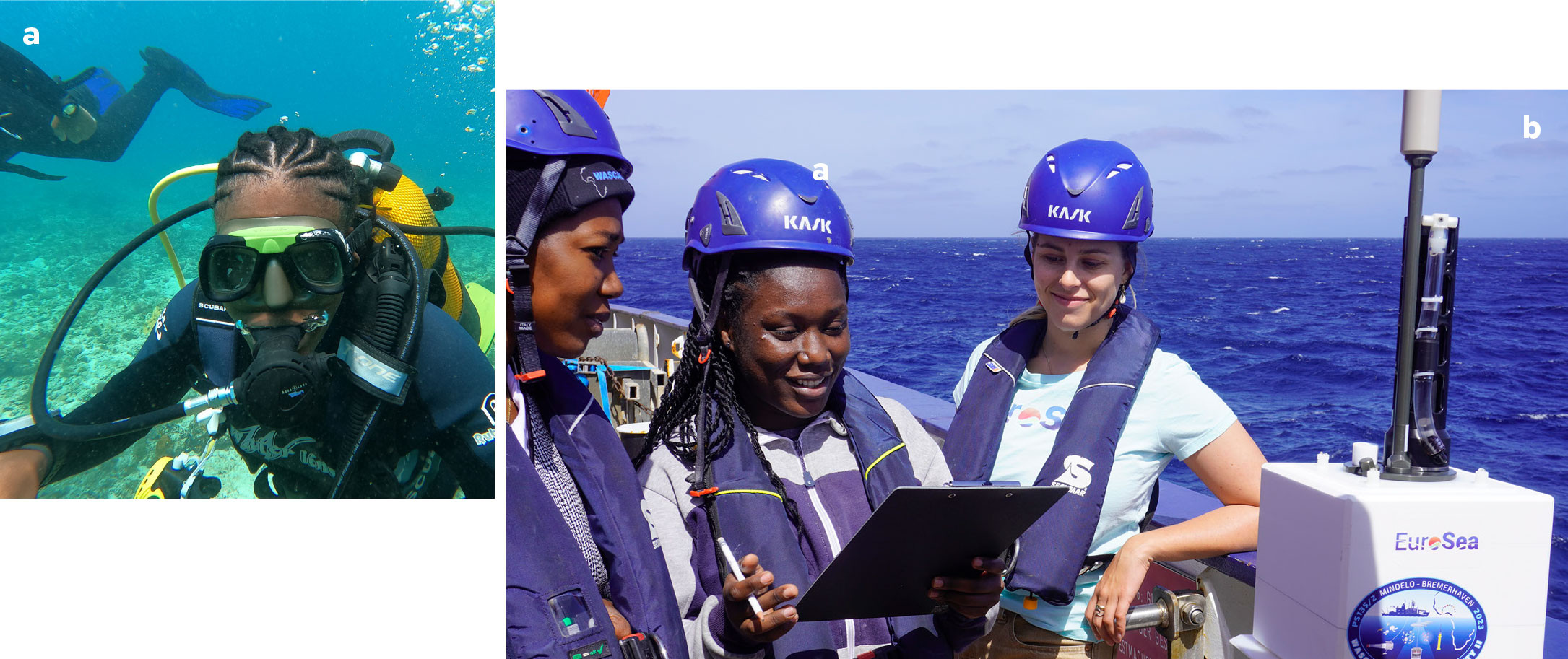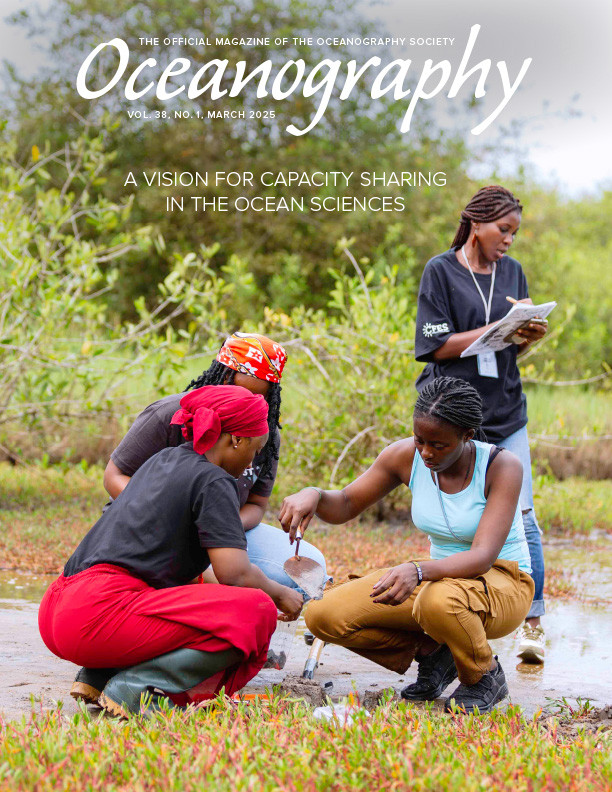Introduction
The Atlantic Ocean off West Africa plays an important role in global climate regulation and critically underpins the socioeconomic stability of the region. The highly productive coastal upwelling system offshore Senegal, Mauritania, and Cabo Verde, fueled by high dust deposition from the Sahara, nurtures a biologically diverse marine food chain (Chavez and Messié, 2009). Artisanal and industrial fishing fleets exploit fish and other marine resources, securing the livelihoods of large sectors of the local population (Belhabib et al., 2015).
This ocean region is also subject to increasing anthropogenic pressures that are driving global change. Physicochemical changes (e.g., ocean warming, coastal erosion, reduction of dissolved oxygen in subsurface waters) are exerting increasing pressure on the region’s ecosystems. Observations indicate a geographical shift of individual fish species northward toward cooler waters (Sarre et al., 2024) as well as both horizontal and vertical spatial reduction of larger predators’ habitats that results from a decline in dissolved oxygen (Stramma et al., 2012). Fragile socioeconomic conditions exacerbate these impacts, increasing the region’s vulnerability to climate change.
Cabo Verde, a Small Island Developing State (SIDS) located in the open ocean off West Africa, is affected by these changes. Due to limited terrestrial resources, Cabo Verde’s economy and well-being disproportionately depend on the services provided by the local marine ecosystem, including tourism, fisheries, and transportation. Similar to other SIDS, this nation’s capacity for informed decision-making toward sustainable management of marine ecosystems is very low (IOC-UNESCO, 2020; Zitoun et al., 2020).
In Cabo Verde and many other countries in West Africa, there are not only technical capacity gaps, such as lack of research infrastructure, but also inequitable access to higher academic education, as highlighted in the Ocean Decade Africa Roadmap that is part of the UN Decade of Ocean Science for Sustainable Development (Ocean Decade; IOC-UNESCO, 2022). Moreover, the Ocean Decade “Vision 2030” white paper on Decade Challenge 9 further emphasized the importance of removing existing gender and language barriers in ocean sciences (Arbic et al., 2024). Overcoming the language barrier is a particular challenge in West Africa with its Franco-, Anglo- and Lusophone countries. In addition, cultural factors in the region make it difficult to achieve
gender balance.
In this article, we describe a long-term partnership between Cabo Verdean and German institutions that commenced 20 years ago and continues to grow. We elaborate on the evolution of the partnership, lessons learned, and how this partnership aligns with the Ocean Decade. Over 20 years, the partnership has developed toward a truly capacity-sharing approach, with research and education infrastructure established in West Africa.
Partnership Building
In 2004, Cabo Verde and Germany convened a workshop entitled “Towards a West African Science Logistics Centre in Cabo Verde.” International scientists from marine, atmospheric, and geological disciplines exchanged perspectives on research priorities and identified capacity gaps that posed a challenge to research activities in the region. Clear needs were identified for research infrastructure, such as a local research vessel and suitable onshore laboratory facilities, and for strengthening human resources.
In 2006, initial onshore and offshore infrastructures were created through a Coordinated Support Action (CSA) of the European Commission, which played a crucial role in solidifying the partnership of the two countries. Within the framework of this CSA, a small fish trawler operated by the local Instituto do Mar (IMar, formerly known as INDP) was overhauled and outfitted to conduct scientific surveys throughout the archipelago and its wider exclusive economic zone. In addition, a small laboratory for biological and chemical analyses was constructed onshore, and scientists from Cabo Verde, Germany, and the United Kingdom installed basic infrastructure for atmospheric observations near the coast. These actions laid the foundation for the establishment of companion time-series observatories in both the marine and atmospheric domains.
Along with these advancements, Cabo Verdean scientists and technicians received technical training on an individual basis through leveraging existing capacity development opportunities such as fellowship programs offered by international organizations. Training visits in both countries as well as joint participation in several oceanographic expeditions on German research vessels have imparted not only specific skills but also facilitated intercultural exchange and building of trust.
The partnership established in those early days was mainly driven by scientific objectives and focused on building capacity in oceanography in Cabo Verde. As a result, only a limited number of stakeholder groups were involved in the partnership. In subsequent years, this community of stakeholders grew steadily, and cooperation was expanded to include universities and authorities such as the Cabo Verde Coast Guard. From then on, such activities as fieldwork or training events were increasingly planned and carried out jointly.
From Projects to Sustained Infrastructure
After this initial building phase of the partnership, technical capacities and knowledge shared among the partners formed the basis for the establishment of Cabo Verde’s first ocean time-series station—the Cape Verde Ocean Observatory (CVOO)—located 60 nautical miles offshore in the open eastern tropical North Atlantic (Lange et al., 2024). Researchers and technicians from IMar conducted regular ship-based sample collection and analyses at CVOO as part of various third-party-funded research projects. Observations with the local small research vessel at CVOO were complemented by a long-term, multidisciplinary mooring program operated by the German partner GEOMAR (Figure 1). All data are shared among partners and are also publicly available via the PANGAEA data repository (Lange et al., 2023).

FIGURE 1. Schematic of the multidisciplinary mooring that is currently installed at the Cape Verde Ocean Observatory. Credit: Christoph Kersten, GEOMAR. > High res figure
|
With a focus on process studies in the eastern tropical North Atlantic, research funding was also used for the continuation of CVOO and further involvement of Cabo Verdean early career ocean professionals (ECOPs) in oceanographic research. Resources for accessing the ocean are very limited locally, and dedicated research projects often provided the means for fieldwork, graduate opportunities, and specific (one-time) capacity development activities such as workshops or summer schools.
As a SIDS, Cabo Verde largely relies on external funding sources to conduct costly marine research and to support maintenance of required infrastructure. However, fixed-term and third-party funding programs often change their objectives, which makes it difficult to develop human and technical capacities in a tailored and long-term manner. Researchers from Cabo Verde experienced disrupted operability of previously established seagoing platforms and laboratory infrastructure, resulting in a lack of essential research time.
Recalling the demands that were articulated back in 2004 and after six years of intense collaboration, the concept for a sustained marine science and logistics center in Cabo Verde was expanded and further co-designed and presented to decision-makers in both countries. Based on achievements of the existing partnership and the willingness of both countries to strengthen it, construction of the Ocean Science Centre Mindelo (OSCM) began in 2014, and it was inaugurated in 2017 (Figure 2). The OSCM is designed as a technical facility to serve the fieldwork of national and international researchers. The operational concept of the center matches well with a “capacity sharing” approach as defined by Miloslavich et al. (2022). The center is operated on site by Cabo Verdean scientists and technicians who have contributed to and benefited from the bilateral partnership from its beginning (Figure 3). Management is shared equally by the partners at IMar and GEOMAR, ensuring the fusion of regional and international perspectives as well as network expansion.

FIGURE 2. (a) Aerial picture of the Ocean Science Centre Mindelo (OSCM) based at the Instituto do Mar (IMar) in Mindelo, Cabo Verde. The center is co-managed by IMar and Germany’s GEOMAR, with IMar personnel operating the center locally. (b) The Cape Verde Atmospheric Observatory (CVAO) is located directly downwind from the shore and measures undisturbed aerosols, trace gases, and other parameters of the marine boundary layer. Photo credits: (a) Edson Silva Delgado (b) Johannes Lampel. > High res figure
|

FIGURE 3. Analysis of field samples in the OSCM biogeochemistry laboratory. Ivanice Monteiro (MSc) joined the partnership during the initial phase as a student. She now oversees the OSCM laboratories and coordinates the team working there. Photo credit: Björn Fiedler, GEOMAR. > High res figure
|
From Bilateral Cooperation to Regional Impact
In addition to facilitating research, OSCM serves as a key platform for diverse stakeholder engagement at national, regional, and international levels. The center has successfully hosted various events, including international scientific symposia, international program meetings, numerous training activities, and outreach initiatives at science-policy and science-society interfaces. Events such as the annual Cabo Verde Ocean Week or the Ocean Race Summit have further strengthened this exchange, promoting cross-sectoral collaboration and partnership development.
One major achievement in 2019 was the establishment of an international, two-year master’s research program on Climate Change and Marine Sciences (MRP-CCMS), hosted by Universidade Técnica do Atlântico (UTA) in Mindelo. It is part of the larger West African Science Service Centre on Climate Change and Adapted Land-Use (WASCAL) program funded by the German Federal Ministry of Education and Research (BMBF), and it is endorsed as an Ocean Decade Project. One applicant from each of the current 12 WASCAL member countries (Figure 4) is selected per cohort and awarded a full scholarship to study and conduct fieldwork for thesis research in Cabo Verde. On average, half of the master’s students per cohort are female. Students in each cohort originate from Franco-, Anglo-, and Lusophone countries in West Africa, and they bring different cultural and religious backgrounds. Before arriving in Cabo Verde, Franco- and Lusophone students participate in four months of English language training in Ghana; Anglophone students get French language training in Togo. In 2019, experienced university professors and ECOPs from Cabo Verde were asked to manage the study program at UTA. Currently, the fifth student cohort is being recruited.

FIGURE 4. Locations of established research infrastructures in Cabo Verde including the Cape Verde Ocean Observatory (CVOO), the Cape Verde Atmospheric Observatory (CVAO), and the Ocean Science Centre Mindelo (OSCM), as well as the regional impact area represented by the 12 WASCAL member countries. Image courtesy of Christoph Kersten, GEOMAR. > High res figure
|
The MRP-CCMS curriculum consists of multidisciplinary modules taught on site by international researchers from academic institutions in West Africa, Europe, and South America. Many of the students join ongoing research projects of local or international researchers at OSCM and other entities, thus learning how to engage in research projects and expanding their professional networks (Figure 5a).
In addition to attending lectures and other trainings such as lab courses, each student cohort also participates in special at-sea training aboard a German research vessel. During so-called “floating university” expeditions between Cabo Verde and Germany, training under authentic research conditions not only teaches students specific technical skills for marine research but also challenges them in skills such as self-organization, responsibility, teamwork, and reliability (Figure 5b). For most students, this is their first experience in conducting research at sea, and many describe it as eye-opening, helping them to grasp how marine ecosystems respond to anthropogenic activities in their home countries and globally.

FIGURE 5. (a) Bôla-nlé Christelle Akonde from Benin, who learned first to swim and then to dive for her master’s fieldwork, is shown working under water as part of an international research project in Cabo Verde. Bôla graduated from the WASCAL master’s research program “Climate Change and Marine Sciences” as part of the third student cohort (2022/2023). (b) Amie Ndure (left) from The Gambia and Osvaldina Soares (middle) from Cabo Verde learned how to deploy an Argo float during a floating university expedition that ran from Cabo Verde to Germany. Image credits: (a) Paulo Pinheiro, (b) Björn Fiedler, GEOMAR. caption text > High res figure
|
The alumni network, which includes the first three cohorts (2020–2023), currently comprises 34 individuals. After graduation, alumni have pursued a variety of pathways. Thirty-six percent of students (n = 28) have gone abroad, while the others have returned to their home countries to work in public (36%) and private (45%) sectors. About 29% continued their scientific careers in PhD projects in Europe, North America, or Africa, and 43% of all students have already published at least one paper. To date, about 39% of the alumni have not yet found jobs. About half of the alumni are actively engaged in the Ocean Decade via the ECOP program. National ECOP nodes in Senegal, Togo, and Benin are coordinated by the alumni. Through networks and individual careers, WASCAL alumni actively disseminate their knowledge and the experiences gained in Cabo Verde, thereby fostering new South-South and also North-South collaborations and ultimately facilitating informed decision-making in West Africa.
Conclusion
The partnership between Cabo Verdean and German institutions has organically evolved over 20 years from a primarily research-driven and project-based approach to a long-term and sustained hub for capacity sharing in West Africa. This hub integrates technical research infrastructure, long-term ocean observations, international projects, enhanced human capacities, regional academic programs, and knowledge exchange with local and global stakeholders. Its objectives are consistent with the key recommendations for Ocean Decade Challenge 9 (Arbic et al., 2024): (1) develop human resources at individual and institutional levels, (2) create supportive regional networks to develop capacity and to facilitate ocean science opportunities, (3) increase representation of underrepresented groups such as women and ECOPs, (4) improve global access to technology and physical infrastructure, and (5) remove language barriers between different users of the ocean.
In retrospect, establishing, maintaining, and further developing such a North-South partnership is not a steady and linear process that can be planned and designed like a research project. Building trust, exchanging ideas and perspectives on an intercultural level, and learning together from mistakes are processes that take a lot of time but also greatly enrich the collaboration. An important aspect of a balanced partnership is developing an understanding of all partners’ priorities, the means they have to achieve certain objectives, and how their decision-making processes are structured. Compromising on one’s own objectives and displaying willingness to co-design objectives was challenging during early stages of the partnership but became key for success at later stages.
Although major achievements and significant impacts have been realized, challenges remain. Many ECOP beneficiaries of this Cabo Verde hub still struggle to find employment in the West African labor market, whether in academia or the public and private sectors. To overcome these challenges, a closer link between the master’s research program and the regional blue economy sector as well as expanded opportunities for doctoral programs are proposed for the future.
Finally, accessing the ocean for marine research, education, and entrepreneurship in the blue economy sector is considered key for successful programs. In West Africa, capacities of seagoing platforms are too low, which hinders effective implementation of capacity sharing programs in the region. Occasional availability of international research vessels from outside West Africa only partially mitigates this deficit and does not meet current or future needs. New transdisciplinary and private-public partnerships are critical to overcoming this severe capacity gap and empowering ECOPs and others to shape the future in a changing world.
Acknowledgments
The authors express their gratitude for continued support from the Cabo Verdean Ministry of the Sea and the German BMBF, and the administrative boards of IMar, UTA, and GEOMAR. The CSA “TENATSO” was funded by the European Commission (grant ID 37090). WASCAL is funded by the German BMBF. GEOMAR acknowledges financial support for WASCAL through BMBF grant no. 01LG2302A. IMar acknowledges UNESCO regional funding for OSCM (grant no. 3240115407). The Cabo Verdean-German partnership owes much to the efforts of Doug Wallace, Martin Heimann, Oscar Melicio, Carlos Ferreira Santos, and many others. The authors thank all collaborators contributing to the WASCAL MRP-CCMS as teachers, mentors, and instructors.






